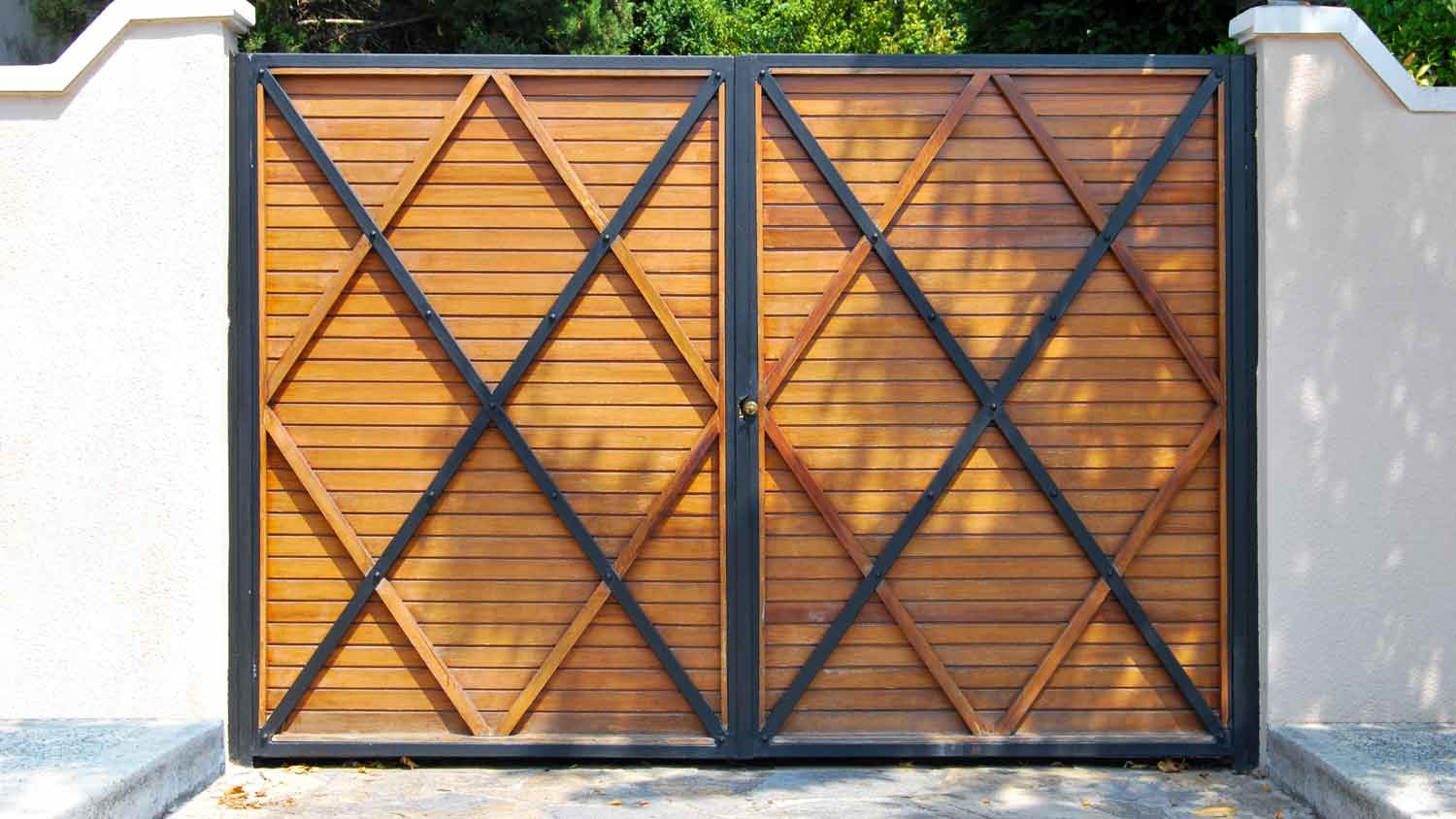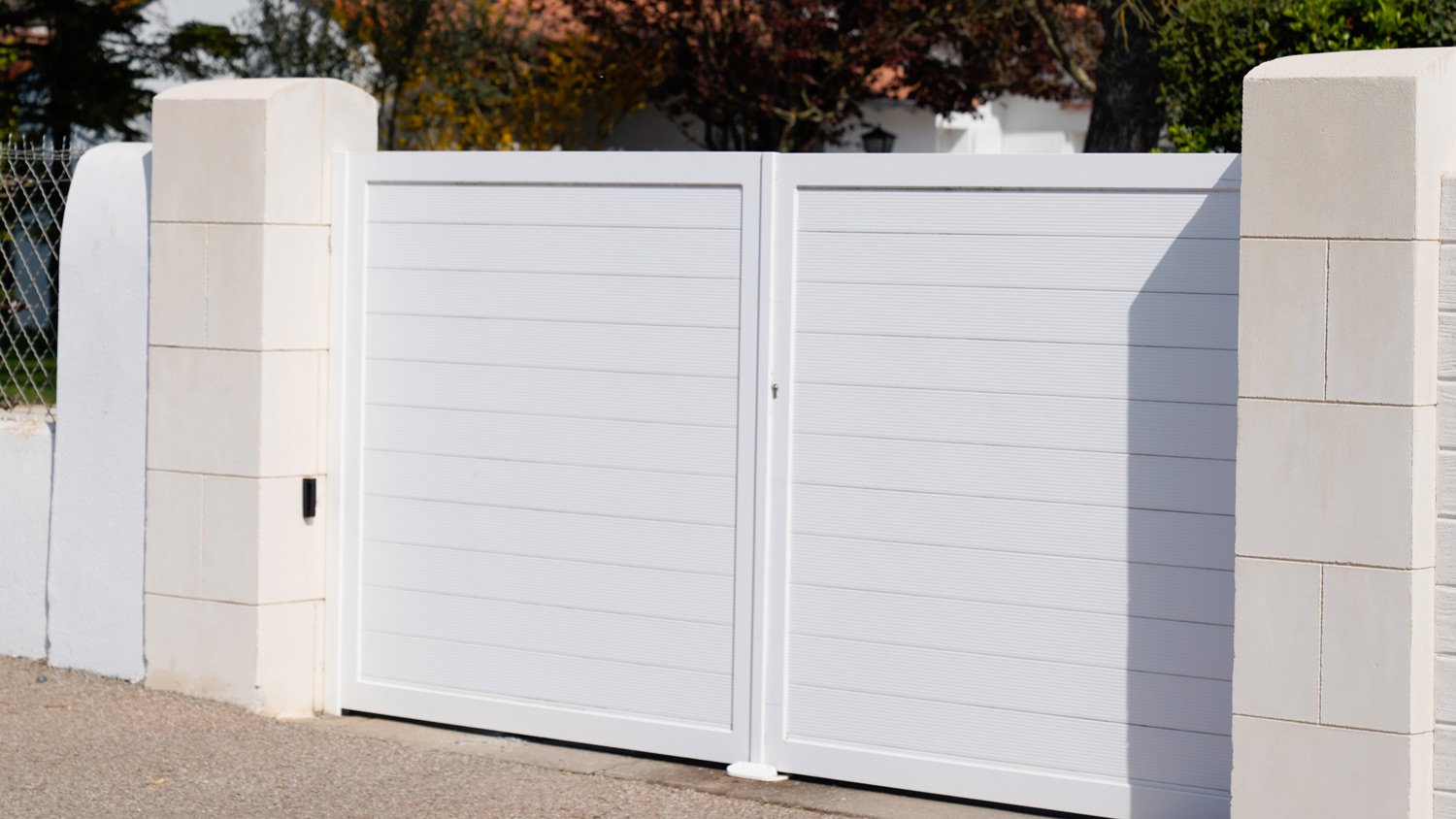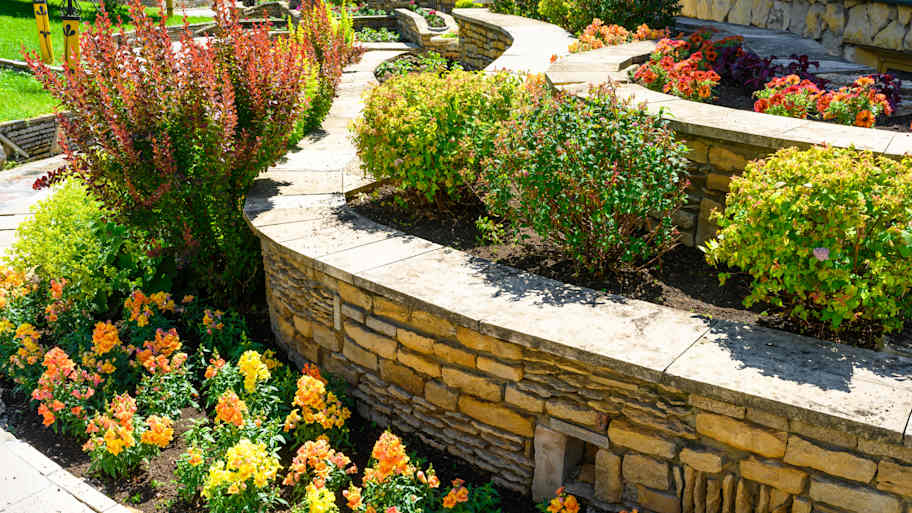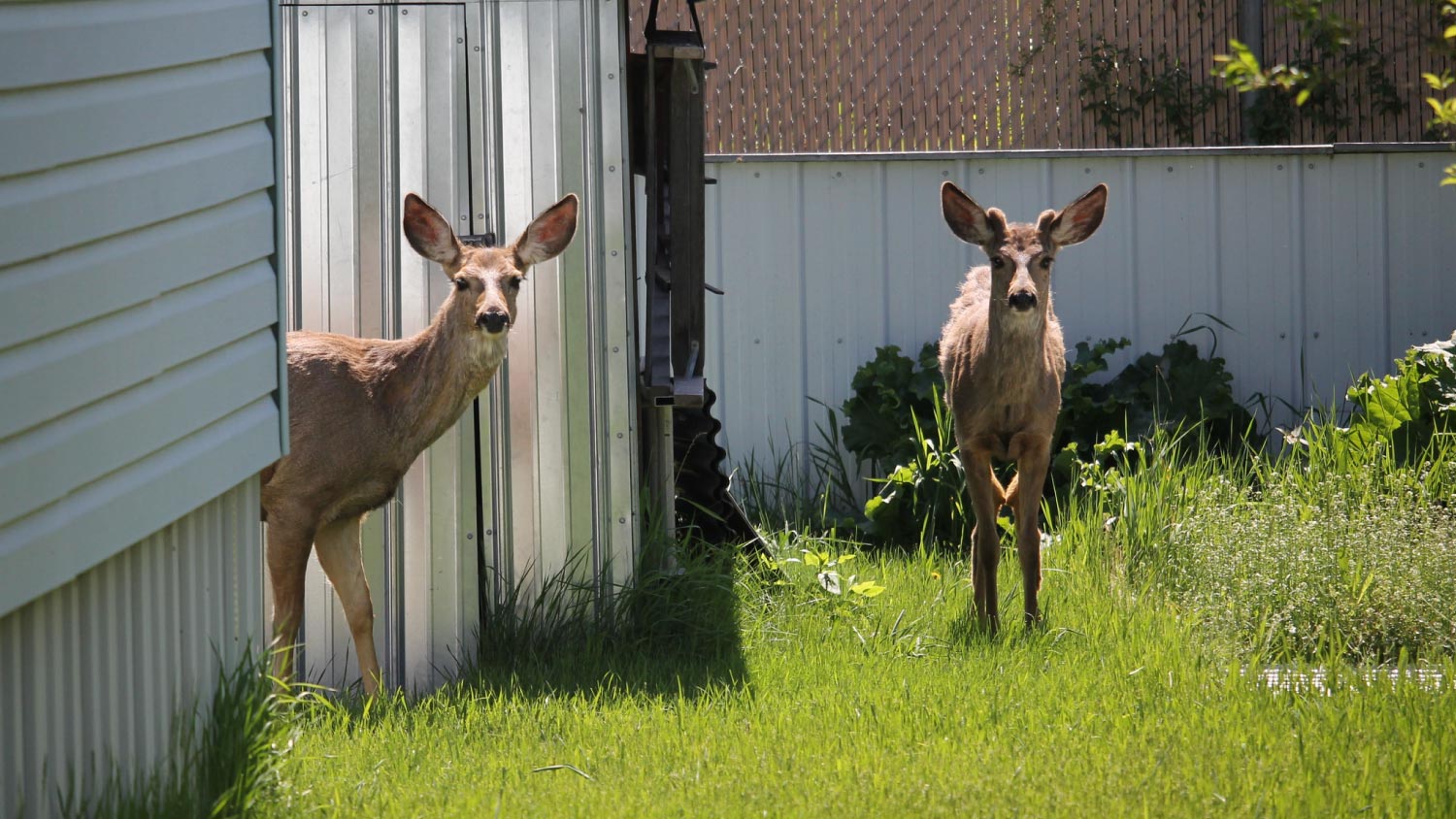
An electric fence is an effective way to keep animals in your yard. Learn how much different electric fences cost, in this guide.
Screen your yard entryway to create a secluded sanctuary


Traditional wrought iron gate types are guaranteed to add classic curb appeal. However, they don’t provide much privacy from the prying eyes of passersby or block your barky dog's view of the neighborhood squirrels. If you want to enclose your space completely, you can use many privacy fence ideas on gates—such as fabric screens, greenery panels, privacy tape, and a botanical approach with climbing vines—your choice will depend on your desired aesthetic, budget, and skills.
Learn how to cover a metal gate for privacy with these easy, customizable, and budget-friendly methods. Best of all, you don’t need to be a DIY expert to install them.

The louver design of ornamental privacy slats allows you to slide them into a full screening position or turn the angle 90 degrees to let in a breeze or provide a clear view to welcome guests. Typically made from high-density polyethylene, they offer a seamless aesthetic and are durable and easy to install.
Instructions depend on the manufacturer’s slat design. To select the most appropriate size, account for gate height and the width between the wrought iron picket posts. You need one slat per picket on the gate.
Depending on your gate height, you may need to trim the slats for a neat fit, allowing a 1/4-inch leeway. Use a miter saw on the reverse blade or a band saw for a smooth cut. Once cut, pull the first slat open and snap it over the first picket on the wrought iron gate. Ensure you secure it onto the full length of the picket. Using a rubber mallet can speed up the process. Repeat until the gate is complete.
To increase security and peace of mind, lock the strips to prevent the panels from being pushed into an open position. This method of gate covering can be more involved and labor-intensive, but it offers customization that the other methods don’t. Expect to pay between $2 and $6 per linear foot, or $4 to $36 per square foot for privacy slats.

Many inexpensive faux foliage panels work as gate covers for privacy, and they are a cinch to install. For a budget option, select a roll of lightweight privacy fence fabric. You can also opt for a wire mesh if you want something more durable, especially if strong winds frequently batter your yard.
Faux foliage panels and fabric fence cover rolls come in various designs, shades, and sizes. Pick the one that fits best with your gate size, landscape aesthetic, and budget.
If you want a consistent, tidy finish on both sides of the gate, buy enough panels or fabric to fit. The backside of the faux foliage panels isn’t the most attractive. How you attach the panel or fabric to the gate depends on the model, some use cable ties, and others come with easy-to-use fasteners. They take about the same time to install, and it’s one of the easiest DIY projects (once the panels are secure, which isn’t particularly difficult).
If the panel is slightly overhanging the top, bottom, or side of the gate, trim it to achieve a neat fit. Most polyethylene structures or fabrics are trimmable using sharp scissors. Expect to pay between $1 to $4 per linear foot of mesh screening or $4 to $16 per square foot.
Check your local regulations before building a tall fence. Most cities will allow you to build a 6-foot fence, but special permits may be required for fences over 7 feet. A fencing expert will know all of the laws in your area, so consider calling a local pro.

If you want a sustainable, natural, attractive wrought iron gate cover, why not try bamboo or—budget-friendly but less durable—reed screens?
Getting a panel that fits your gate as close as possible saves you from having to cut the bamboo or reed to fit. However, if you need to trim the panel to fit your gate, the tools you use depend on its thickness. Always cut right to a node; this reduces the chance of exposed ends accumulating rain and reducing the screen's lifespan.
Something else to consider—and ask—is that some bamboo panels come pre-treated, but wood staining untreated bamboo increases its longevity. Make sure to check if it’s pre-treated when you purchase it.
Once cut, a bamboo screen is easy to fasten using cable ties, which you can trim once secure, or galvanized pliable wire. Don’t attach the panels too close to the ground because it encourages moisture absorption and may lead to the fence breaking down over time.
Of all the possible gate coverings, bamboo is the easiest to DIY, and also one of the least expensive. DIYers should budget around $1 to $5 per linear foot for bamboo screening, or $5 to $20 per square foot.

Using wood for privacy is an attractive and durable option, but installing it on a wrought iron gate can be more pricey and difficult. However, unlike the more complex process of building a fence or gate from scratch, it is still a task within reach of even the most novice DIYers.
The easiest option is to install a pre-cut panel, but you can also attach individual planks for a slat-style finish. Below is a concise overview of installing a carefully measured pre-cut panel.
The hinges for your gate need to be in good order to hold the extra weight of the wood panel. If the hinges look worn or wobbly, replace these with a suitably strong new hinge type before installing the panel. You may need to apply a weather- and pest-proofing stain or paint (with primer) to the panel before installation.
Removing the gate makes it easier to position the holes and secure the panel accurately when drilling into metal. When drilling the holes in the gate, it’s worth using matching gate paint on these holes. This makes it less likely that they will rust when exposed to moisture.
Drill pilot holes into the wooden panel and use washers before inserting the screws to reduce the risk of splitting. Wear safety goggles to prevent the risk of injury from flying metal or wood shards.
If you remove the gate to add the panel, you’ll need to know how to hang a gate back up. Ask friends or family to hold the gate in place while you reattach the hinges using a drill and screws.
While this isn’t the most complicated DIY job, the weight of the gate and the materials themselves make it more of a two or three-person job. If you save labor and DIY the project, expect to pay around $400 to $1,200 for materials (assuming you have the required tools).

Corrugated metal and plastic panels can cover gates, but they are often left out of residential applications. While they certainly stop nosy neighbors from checking out your yard, they lack the curb appeal that other options possess.
However, corrugated metal and plastic are inexpensive and easy to install. If there is an existing gate, you can attach corrugated metal with a simple screwdriver or nail gun; the same goes for plastic panels.
Those who choose to use less expensive (and less inviting) materials such as corrugated metal and plastic can expect to pay between $4 and $7 per square foot or $17 to $90 per linear foot.
The cost of a new gate depends on many factors. Other than what you plan to cover it with, you need to decide if you want an automatic (electric) gate, or a manual one that either swings open or rolls on tracks. Automatic gates are much more involved in installation and expertise and can cost, on average, around $3,200.
The three types of automatic gates are:
Sliding gate: $700–$4,080
Swing gate: $840–$6,000
Vertical lift/pivot gate: $500–$12,000
Many homeowners opt for a manual gate if they don’t want to rely on the moving parts of an automatic gate, or don’t use an access point enough to warrant the extra expense. Automatic gates also require regular maintenance, and issues are not always simple to fix. A manual gate is much less expensive and doesn’t produce complicated problems, with costs ranging between $300 and $800, depending on the materials you use and how much labor is required.
From average costs to expert advice, get all the answers you need to get your job done.

An electric fence is an effective way to keep animals in your yard. Learn how much different electric fences cost, in this guide.

Find composite fencing costs based on fence type, labor, and more in this guide. You can expect your project to cost $11 to $45 per linear foot.

Silt fence installation costs vary depending on the size of the lot, the fencing type, and the installation technique. Use this guide to get the budget right.

Explore 5 common types of chain-link fences: galvanized, vinyl-coated, privacy, mini-mesh, and security. Find the perfect fit for your property needs.

Not sure how to calculate blocks for your retaining wall? Here’s how to figure it out based on the size of your wall and the dimensions of your blocks.

Discover the cost of deer fence installation. Learn about average prices, key cost factors, and tips to save on your deer fence project.